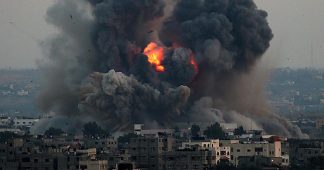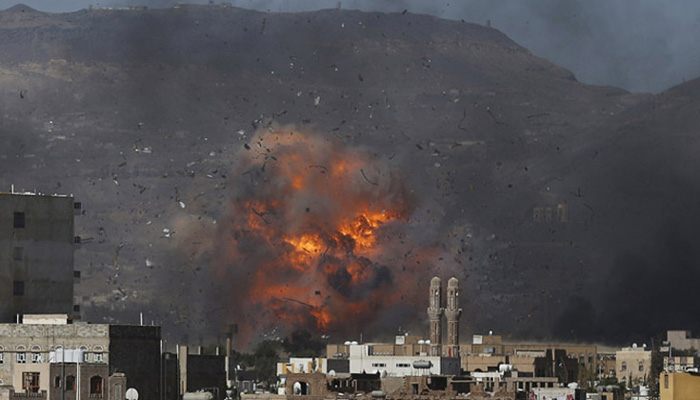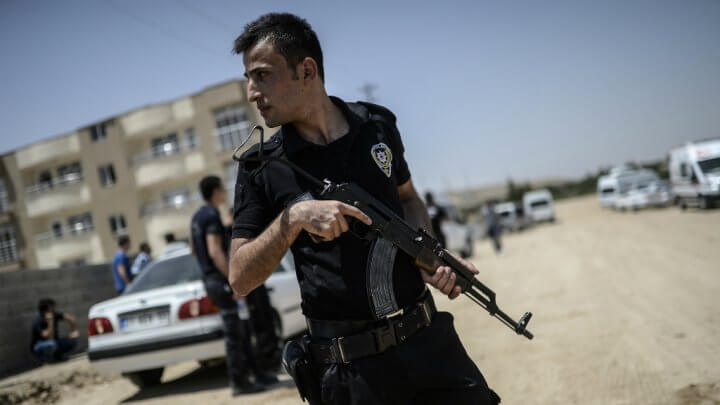By Itamar Mann
“Roof knocking” is a controversial method of bombing ostensibly intended to minimize civilian casualties. Israel introduced the method in its campaign in Gaza in 2008–2009, and according to the protocol it developed, occupants of a building are given two warnings before a military strike. The first warning is a phone call. The second warning is a rocket.
Israel has explained the assumptions roof knocking is supposed to rest upon on various occasions. Due to these warnings all civilians are expected to have evacuated the attacked building, while armed combatants presumably have remained in hiding. Any cache of arms the latter might be sitting on will have stayed put.
Then comes the actual attack, in which the combatants and their weapons are targeted. The term — in the Hebrew original “hakesh bagag” — translates in the imperative form: “knock on the roof.”
In late April, the United States announced that it had used the method in bombing an ISIS target in Iraq. As The Washington Post reported, the attack was initiated on April 5 in the Northern Iraqi city of Mosul. Alongside the Syrian city of Raqqa, Mosul is one of ISIS’s two main strongholds.
It is yet unclear if and how US security forces will regularize the method. Army Colonel Steve Warren — a spokesman for the US-led coalition in Iraq and Syria — said the use of roof knocking was experimental: “a test to see if it worked… it didn’t.” After the warning blast, a woman it intended to alert apparently ran back into the targeted structure. Yet US military sources acknowledged that roof knocking might be used again.
The controversy around roof knocking has so far been cast in legal terms, in the vocabulary of international humanitarian law and specifically with reference to the targeting rules in the First Additional Protocol to the Geneva Conventions.
While binding and unquestionably important, this legal framework obscures fundamental moral concerns that stem from the way roof knocking conflates communication with bombing. “Talking with bombs” is dangerous; it is symptomatic of a new form of fighting that — for all practical purposes — has given up on the hope to end war.
Roof Knocking and Civilian Lives
In a memorable post at Opinio Juris, legal scholar Janina Dill provided a comprehensive legal argument against roof knocking. Before clarifying what I believe are the more salient moral concerns, it’s worthwhile to explain the threefold legal critique.
First, critics have argued that these warning are of no avail to civilian population. In Gaza civilians were often not granted enough time to evacuate their homes before a warning shot transformed into a deadly blast.
Second, some have argued that “roof knocking” is itself a violation of international humanitarian law. Rather than protecting civilians, it is intended to “spread terror among the civilian population.” The terrifying character of roof knocking is apparent in several of its online videos, but also implicit in its Hebrew label. Demanding that someone “knock on the roof” ironically suggests that bombs can indeed knock, implying that a fighter jet can transform roofs into doors.
Third, roof knocking may at times be used to justify civilian casualties. It has been suggested that when civilians are given an opportunity to save themselves, their failure to do so is their own responsibility. The upshot is that “roof knocking” may allow powerful military actors to increase, rather than decrease, civilian casualties.
The most fundamental point hinges on Article 57 of the First Additional Protocol to the Geneva Conventions, which prescribes that “effective advance warning shall be given of attacks which may affect the civilian population, unless circumstances do not permit.” Yet it also unequivocally states that “[n]o provision in this article may be construed as authorizing any attacks against the civilian population, civilians or civilian objects.” In Dill’s view, roof knocking likely violates the latter part of the provision.
One might accept, however, for the sake of argument, the factual assertion that “roof knocking” sometimes can save lives. Compare two hypothetical scenarios in which a military engages in the same number of individual attacks. In one, it uses “roof knocking” to warn civilians. In another, it doesn’t. It is at least possible that, all else being equal, more civilians may end up dying in the latter situation. In such circumstances — when roof knocking actually saves lives, there is a good argument that it is legal. Is there still something wrong with roof knocking?
Communicative Bombing
Roof knocking represents a universe in which weapons are deployed as means of communication. It is the flip side of another important development that we have become acquainted with in recent years, the idea that means of communication are now becoming powerful weapons.
Save for a few exceptions concerning warning shots (see e.g., here and here), international humanitarian law does not deal with the fact that we will talk with bombs. But this form of communication is a symptomatic part of an emerging political environment in which international humanitarian law is now applied. Considering the novelties of this environment may allow us to rethink the relevant legal questions without granting law an implicit monopoly on judgment. International humanitarian law serves to answer conundrums about permissible behavior in war with an institutionally mandated set of rules. It should not, however, shape our moral understanding of these conundrums to begin with.
From this perspective, it is especially important to consider what it means to conflate communication and bombardment. One way of doing so is by looking at the history of communication between military forces and civilian populations on the battlefield. This long history has arguably constantly tied together humanitarian goals with psychological warfare. There is nothing especially new about the fact that warning civilians can also mean inflicting horror.
To name one famous example, after the bombing of Hiroshima, US forces dropped a leaflet on Japanese cities. The leaflet opened with a dramatic statement: “We are in possession of the most destructive explosive ever devised by man.” The express purpose of this leaflet was to scare the Japanese civilian population into ending the war: “Before using this bomb to destroy every resource of the military by which they are prolonging this useless war, we ask that you now petition the Emperor to end the war.” In this context, communication with civilians was tethered with massive state violence.
On the other side of the spectrum, in the context of the occupations of Iraq and Afghanistan, the US armed forces have employed a rather elaborate theory of counterinsurgency (COIN). Here the purpose was to spin a much thicker network of communication with civilians often by providing services and face-to-face interaction. This would be useful in two ways. First, it would help win the “hearts and minds” of the occupied population. But immersing the occupying power in broad array of civilian activities and services would also be useful for intelligence purposes. Information collected from civilians and social network analysis would identify security threats as they emerge.
In each of the examples above, civilian populations are engaged through language. This does not mean that there is no violence involved, as the atomic bomb example overwhelmingly illustrates. But it does mean that communication with civilian population somehow anticipates what will happen when the war ends. Japanese civilians are quite literally required to contribute to the end of war. They are addressed as the citizens of a potentially stable political order, which will presumably be possible only after surrender. The hearts and minds of Iraqi and Afghan civilians were sought specifically to facilitate peaceful ends to the occupations, with the establishment of more or less independent states. That this did not actually work as planned goes without saying.
From the perspective of international humanitarian law, neither of these modes of communication is free of complications. For example, legal scholar Heidi Matthews has argued that by intensely communicating with civilians, COIN effectively transforms them into objects of military attack.
Leaving those complications aside, the examples above help to illustrate the most morally disturbing aspect of roof knocking. This has to do with a failure to communicate with civilians — indeed with the imagination that such communication is impossible — rather than with the civilian casualties such communication might generate. The critique roof knocking is therefore a paradigmatic site of a much larger concern with the nature of contemporary warfare.
Talking to civilians with bombs is different from more traditional forms of communication with civilians. For example, the Israeli government warns its own citizens of bomb attacks by using a siren as an agreed upon message of imminent danger. But when “enemy civilians” in Gaza are concerned, such a siren presumably does not suffice. No longer on the symbolic level, communication is exercised at a visceral level that seeks to bypass cognition.
To use a metaphor that philosopher Grégoir Chamayou developed in the context of drone warfare, it recalls the way in which an animal might be scared away by a hunter’s shot. Rather than addressing civilians as agents with political will, they are imagined as a protected species.
“Roof Knocking” and the Forever War
To be sure, roof knocking too initially involves a use of natural language. The warning blast is preceded by a phone call. However, this only highlights the problem with the technique. Once again, let’s assume that the theoretical model of roof knocking is perfectly implemented in practice. After the phone call has been placed, anyone who might be persuaded by language has presumably evacuated the targeted structure. Those who remain are only those who want to stay in the building.
The warning blast comes next, an implicit acknowledgement that some civilians want to stay in the structure (they would have otherwise left after the phone call). However, the warning blast also acknowledges that their choice to stay in the structure does not render them “legitimate targets.” In the language of international humanitarian law, they are not “directly participating in hostilities” (that would make the warning blast unnecessary).
So why is the warning blast added to the phone call? It is precisely the political will of the civilian population in the structure that the warning blast aims to break. By seeking to induce one of two responses — fight or flight — it eliminates a third option of resistance. Resistance is often about saying something with one’s body. The warning blast aims to push civilians’ bodies back to instincts of survival.
Both in the context of surrender (Japan) and in the context of ending an occupation (Iraq and Afghanistan), ending war would require an agreement with another sovereign state. For the agreement to be more than just a piece of paper, it needs some popular support among the citizens of that state. Hence the need to communicate; hence the need to engage political will. But talking with bombs rejects political will, and is an attempt to destroy it.
The assumptions roof knocking rests upon are different. Rather than potential citizens of a more or less stable political order, civilians are regarded within the purely utilitarian calculus of reducing casualties. Laudable as saving lives is, international humanitarian law is unable to account for a loss of political agency. While roof knocking probably does not generate such a loss, it does reflect it and give it a material embodiment. An exclusive focus on the imperatives of international humanitarian law — the prohibitions on intentionally targeting civilians and on disproportionately harming them — risks contributing to an endless war.
From Gaza to Mosul and Beyond
The trajectory of roof knocking from Gaza to Mosul is indicative. Recall that in 2005 Israel withdrew from Gaza unilaterally, without reaching and agreement to do so with Palestinian authorities. In Israel, this unilateral withdrawal was at times boasted as an especially broad concession to the Palestinians (“we asked for nothing in return” was the prevailing sentiment). More likely, however, any bilateral agreement would have required that Israel grant much more broader concessions and most importantly, recognize Palestinian sovereignty. Israel of course still staunchly opposes this, preferring instead to “manage the conflict.”
The small strip of land is now under a seemingly unlimited condition of statelessness — neither sovereign nor occupied. This condition is exceptional in the state-centered structure of international law. Consequently, the political agency of Gazan “citizens” enjoys no formal recognition on the international sphere. Being addressed not only by natural language, but intimidating blasts and other violent messages employed directly on the body is part of a more comprehensive mode of governance in Gaza. For a decade now, this governance is conducted through varying degrees of siege. A salient example was the ban on importing certain foods, alongside the military’s caloric calculation, ostensibly to ensure that residents of the strip do not starve.
With the prospect of no recognized government in many ISIS-controlled territories in the Middle East, these territories may soon share the same status, which may no longer be regarded as exceptional. Even if, as we are currently being told, ISIS is losing its grip on areas like Fallujah, the question what’s the plan for the day after is as up for grabs as ever. John Kerry’s pledge to arm the Libyan government similarly leaves open an important question: does such a government exist?
The red thread connecting between Gaza and ISIS-controlled territories has previously been drawn by ISIS propaganda. As one commentator explained, “The group has jumped on the bandwagon of the outrage surrounding the fate of the people living in the Strip without having to be an agent of positive change on the ground.” By adopting roof knocking in Mosul, the US may help in drawing the same line.
Regularized roof knocking would be a good signal that the United States has basically given up on stabilizing existing states, or recognizing de facto control as formal sovereignty. For better or worse, these two alternatives are the instruments international law provides for ending war. Both are beyond the narrow terms of international humanitarian law. Rather than asking whether roof knocking is legal in terms of international humanitarian law, we should ask: What type of political order does communicative bombing reflect? This ostensibly humane technique of warfare may in fact reflect permanent domination.











